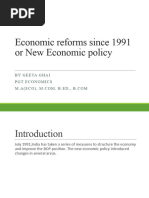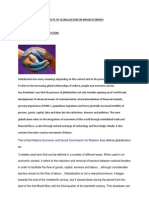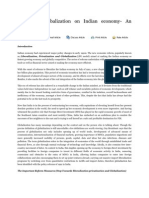0 ratings0% found this document useful (0 votes)
21 viewsIndian Economy
Indian Economy
Uploaded by
syedzakiali333The Indian economy is the sixth largest economy globally. It is classified as a newly industrialized country with a mixed economy model. India has a large workforce employed in agriculture and industry. Key features of the Indian economy include low per capita income, demographic pressures, poverty and inequality, and an agriculture-centric structure. Problems facing the economy are unemployment, poor education, infrastructure issues, and high debt levels.
Copyright:
© All Rights Reserved
Available Formats
Download as PDF, TXT or read online from Scribd
Indian Economy
Indian Economy
Uploaded by
syedzakiali3330 ratings0% found this document useful (0 votes)
21 views20 pagesThe Indian economy is the sixth largest economy globally. It is classified as a newly industrialized country with a mixed economy model. India has a large workforce employed in agriculture and industry. Key features of the Indian economy include low per capita income, demographic pressures, poverty and inequality, and an agriculture-centric structure. Problems facing the economy are unemployment, poor education, infrastructure issues, and high debt levels.
Copyright
© © All Rights Reserved
Available Formats
PDF, TXT or read online from Scribd
Share this document
Did you find this document useful?
Is this content inappropriate?
The Indian economy is the sixth largest economy globally. It is classified as a newly industrialized country with a mixed economy model. India has a large workforce employed in agriculture and industry. Key features of the Indian economy include low per capita income, demographic pressures, poverty and inequality, and an agriculture-centric structure. Problems facing the economy are unemployment, poor education, infrastructure issues, and high debt levels.
Copyright:
© All Rights Reserved
Available Formats
Download as PDF, TXT or read online from Scribd
Download as pdf or txt
0 ratings0% found this document useful (0 votes)
21 views20 pagesIndian Economy
Indian Economy
Uploaded by
syedzakiali333The Indian economy is the sixth largest economy globally. It is classified as a newly industrialized country with a mixed economy model. India has a large workforce employed in agriculture and industry. Key features of the Indian economy include low per capita income, demographic pressures, poverty and inequality, and an agriculture-centric structure. Problems facing the economy are unemployment, poor education, infrastructure issues, and high debt levels.
Copyright:
© All Rights Reserved
Available Formats
Download as PDF, TXT or read online from Scribd
Download as pdf or txt
You are on page 1of 20
Indian Economy
India is the sixth-largest economy (by nominal GDP) in the world.
Economists categories India as a newly industrialized country (NIC).
India is a mixed economy. In India, most of the labour force is
employed in the agriculture and industry sectors.
The developing countries whose economy is growing at a much
higher pace than the other developing countries are called NIC.
Like all the modern economies, India is a mixed economy. Mixed
economies have characteristics of
both capitalist and socialist economies. In India, citizens are free
to choose their profession and start a business of their liking in
any sector. However, there are a few exceptions. Sectors like
defense, power, and banking are highly regulated by the Indian
government. This means that government-owned organizations
exist along with privately-owned entities. Adopting the mixed
economy proved to be advantageous to India in terms of
economic freedom, citizen welfare, and resource allocation
Features and Problems
Important Features of the Indian Economy:
•Low per capita income. India is known worldwide as a country
with low per capita income.
•Intense Demographic pressure.
•Poverty and Inequality.
•Agriculture-centric economy.
•Higher rate of formation of capital.
•Planned economy.
Features and Problems
Problems Faced By Indian Economy:
•Unemployment. ...
•Poor educational standards. ...
•Poor Infrastructure. ...
•Balance of Payments deterioration. ...
•High levels of private debt. ...
•Inequality has risen rather than decreased. ...
•Large Budget Deficit. ...
•Rigid labour Laws.
Changing Dimension of Indian
Business Enviorment
The business environment is the most critical part of any
organisation that includes many internal and external entities such
as suppliers, competitors, the media, the government, customers,
economic conditions, investors, and so on that together make up
the business environment.
Customer demands, Employees, expectations, management,
clients, supply and demand, suppliers, technological innovation,
economic changes, owners, government actions, market trends,
social trends, and so on together form the changing dimensions of
the business environment.
Features of Business Environment
• The external forces totality
• General and specific forces
• Inter-relatedness
• Dynamic nature
Dimensions of Business Environment
• Legal Environment
• Political environment
• Technological environment
• Social environment
• Economic environment
Indian Dimensions
• Prior to liberalisation, India’s growth rate was
around 3.5%.
• After 1991 privatisation,blic sector made an
improvement in efficiency and investments.
• Green revolution and establishment of industries
in rural areas has developed our villages.
• After achieving 9% of growth rate in 2007, India
became the fastest growing economy today.
• CSR responsibilities has been made mandatory
after 2014 in India.
• Banking, financial, service and insurance India r
has become competitive after globalisation.
• It is the second largest two wheeler market in
world, many foreign manufacturers have set up
their plant in India.
Role of Public and Private
sector
Public Sector:
The primary objectives of the public sector are to provide basic
goods and services to the citizens, promote economic
development, and protect the interests of weaker sections of
society.
Private Sector:
The private sector's role is integral to an economy's development.
The private sector delivers vital goods and services, contributes
to tax revenues and ensures the efficient flow of capital.
Problems in Public sector
Major Problems of Public Sector:
•Inefficient Management.
•Lack of Innovations.
•Mounting Losses.
•Political Interference.
•Time and Cost Over-Runs.
•Problems of Autonomy and Control.
•Problems of Price Policy.
•Over Staffing.
Globalization
Globalization is a term used to describe how trade and
technology have made the world into a more connected and
interdependent place. Globalization also captures in its scope the
economic and social changes that have come about as a result.
A manufacturer assembling a product for a distant market, a
country submitting to international law, and a language adopting
a foreign loanword are all examples of globalization.
Privatization and Liberalization
and its impact on Indian Economy
Privatization:
The transfer of ownership, property or business from the
government to the private sector is termed privatization. The
government ceases to be the owner of the entity or business. The
process in which a publicly-traded company is taken over by a
few people is also called privatization.
Liberalization:
Liberalization is the process or means of the elimination of
control of the state over economic activities. It provides a greater
autonomy to the business enterprises in decision-making and
eliminates government interference.
Privatization and Liberalization and its impact on Indian
Economy
1. Increase in the Direct Foreign Investment: The policy of
liberalization has resulted in a tremendous increase in the direct
foreign investment in the industrial and infrastructural sector
(roads and electricity).
2. Enhancement in the Growth of GDP: There is a significant
growth in the Gross Domestic Product (GDP).
An increase in the country's per capita income.
In 1991, the Per capita Income of India was ₹11,235, but in 2014-
15 Per Capita Income reached ₹85,533. Increase in Foreign
Direct Investment from ₹408 Crores in 1991 to ₹106,693 Crores
in 2015 after the introduction of the new economic reforms.
Recent Trends in Indian
Economy
The Indian economy has remained resilient and is on track to
grow by seven percent in the FY 2023 despite the ongoing global
headwinds caused by external factors like post-pandemic
spillovers, supply chain disruptions due to the ongoing Russia-
Ukraine conflict, and potential recessionary pressures facing
developed economies. This resilience can be attributed to large
domestic markets, coupled with consistent efforts on the part of
the government to strengthen the supply side through reforms like
PLI schemes, national logistic reforms, fostering ease of doing
business through digitization, etc. This article outlines measures
aiding India’s business climate and highlights the main
macroeconomic trends and prospects surrounding the Indian
economy in 2023.
Dis-investment
Disinvestment in India is a policy of the Government of India,
wherein the Government liquidates its assets in the Public sector
Enterprises partially or fully. The decision to disinvest is mainly
to reduce the fiscal burden and bridge the revenue shortfall of the
government.
In August 1996, the Disinvestment Commission, chaired by G V
Ramakrishna was set up to advice, supervise, monitor and
publicize gradual disinvestment of Indian PSUs.
You might also like
- Unit 1Document10 pagesUnit 1vidhisolanki787No ratings yet
- Effects of Liberalization On The Indian Economy: Clearias Team December 10, 2022Document8 pagesEffects of Liberalization On The Indian Economy: Clearias Team December 10, 2022Shakti SayarNo ratings yet
- Lecture 3 MGN 101Document32 pagesLecture 3 MGN 101Taukir SiddiqueNo ratings yet
- MBA 205 - Legal Aspect - Unit 8 - Eco EnvironDocument7 pagesMBA 205 - Legal Aspect - Unit 8 - Eco EnvironSoumen SahuNo ratings yet
- India Since 1991: AssignmentDocument9 pagesIndia Since 1991: AssignmentAnurag BishnoiNo ratings yet
- Industrial Policy and Infrastructure English Reviewed 30Document34 pagesIndustrial Policy and Infrastructure English Reviewed 30Girish JoshiNo ratings yet
- Element of Financial SectorDocument4 pagesElement of Financial SectorShubham GargNo ratings yet
- OverpopulationDocument45 pagesOverpopulationNa-Ri LeeNo ratings yet
- Assessing Overall Business Environment in Indian EconomyDocument22 pagesAssessing Overall Business Environment in Indian Economyshivamkarir03No ratings yet
- By Dr. Mahendra Parihar Associate Professor, Mpstme, Nmims MumbaiDocument26 pagesBy Dr. Mahendra Parihar Associate Professor, Mpstme, Nmims MumbaiShrey VyasNo ratings yet
- Unit 1Document35 pagesUnit 1vidhisolanki787No ratings yet
- Structure of Indian EconomyDocument20 pagesStructure of Indian EconomyChow Nakunand SingkaiNo ratings yet
- Efe Unit 6 Part 1Document13 pagesEfe Unit 6 Part 1karanrainavaarNo ratings yet
- UNIT 4 Democracy and Goodgoverance NotesDocument20 pagesUNIT 4 Democracy and Goodgoverance Notesvishnuvijay1966No ratings yet
- Presentation On: Liberalization, Privatization, Globalization and G-20Document40 pagesPresentation On: Liberalization, Privatization, Globalization and G-20sowmya sNo ratings yet
- Liberalization: Objectives of Liberalization PolicyDocument3 pagesLiberalization: Objectives of Liberalization PolicyshailendraNo ratings yet
- Implications of Reforms On The Economic Growth of India: AbstractDocument9 pagesImplications of Reforms On The Economic Growth of India: AbstractManju NathNo ratings yet
- GOBALIZATIONANDITSIMPACT HDHDHDDocument7 pagesGOBALIZATIONANDITSIMPACT HDHDHDthakurakshat0788No ratings yet
- Social Studies-IDP ProjectDocument12 pagesSocial Studies-IDP Projectsrinivasvanaja02No ratings yet
- Globalization & LiberalizationDocument12 pagesGlobalization & Liberalizationmitul-desai-8682No ratings yet
- Globalisation: Effect of Globalisation in IndiaDocument4 pagesGlobalisation: Effect of Globalisation in IndiaARYA S PILLAINo ratings yet
- Fesf PDFDocument32 pagesFesf PDFameeNo ratings yet
- Economic Structure of IndiaDocument22 pagesEconomic Structure of IndiaShreedhar DeshmukhNo ratings yet
- Module 2-2Document13 pagesModule 2-2atik palNo ratings yet
- IEPDocument50 pagesIEPK.muniNo ratings yet
- Indian Trade Economy Met and Adopted A New Hemisphere Where LPG Was IntroducedDocument4 pagesIndian Trade Economy Met and Adopted A New Hemisphere Where LPG Was IntroducedMahek GillNo ratings yet
- Impact of Globalization in Bangalore: Arpan Lakhani DI 10006Document8 pagesImpact of Globalization in Bangalore: Arpan Lakhani DI 10006arplakhaniNo ratings yet
- Economic Reforms INDIADocument7 pagesEconomic Reforms INDIArockydarkNo ratings yet
- What Were The Reasons Behind The 1991 Economic Reforms in IndiaDocument6 pagesWhat Were The Reasons Behind The 1991 Economic Reforms in Indiaadeol5012No ratings yet
- Current India EconomyDocument3 pagesCurrent India EconomyAzmir DewanNo ratings yet
- Module 2Document60 pagesModule 2angelchakrabortyNo ratings yet
- Economic Growth in India An OverviewDocument3 pagesEconomic Growth in India An Overviewdeanmatthews440No ratings yet
- Librelization, Privatization and GlobalizationDocument12 pagesLibrelization, Privatization and GlobalizationYugam JoshiNo ratings yet
- Understanding Indian EconomyDocument12 pagesUnderstanding Indian Economygn3066304No ratings yet
- IMPACT OF GLOBALIZATION ON INDIAN AGRICULTURE: AN OVERVIEW OF THE INDIAN ECONOMY - Dr. B. NAGARAJUDocument10 pagesIMPACT OF GLOBALIZATION ON INDIAN AGRICULTURE: AN OVERVIEW OF THE INDIAN ECONOMY - Dr. B. NAGARAJUBandameedi Nagaraju Ph DNo ratings yet
- Liberalization in India - 1991: Slide 2 (Introduction)Document4 pagesLiberalization in India - 1991: Slide 2 (Introduction)Vidit AgrawalNo ratings yet
- Impact of Liberalization & Privatization On Indian EconomyDocument13 pagesImpact of Liberalization & Privatization On Indian EconomyNitesh SinghalNo ratings yet
- The Impact of Globalization On Indian EconomyDocument15 pagesThe Impact of Globalization On Indian Economyronik25No ratings yet
- Impact of Liberalization, Privatization & Globalization On Indian EconomyDocument13 pagesImpact of Liberalization, Privatization & Globalization On Indian EconomyYogesh GuptaNo ratings yet
- An Overview of The Indian Economy Is Crucial For Competitive ExamsDocument4 pagesAn Overview of The Indian Economy Is Crucial For Competitive ExamsvenkatapuramdaNo ratings yet
- 404 Ib Ie&td NotesDocument75 pages404 Ib Ie&td NotesDr. Rakesh BhatiNo ratings yet
- Economics of Tourism 1ST UnitDocument25 pagesEconomics of Tourism 1ST UnitAbhishekNo ratings yet
- Economic Reforms Since 1991 or New Economic PolicyDocument41 pagesEconomic Reforms Since 1991 or New Economic PolicyGeeta GhaiNo ratings yet
- LPGDocument11 pagesLPGRobinvarshneyNo ratings yet
- Liberalization of IndiaDocument18 pagesLiberalization of IndiaManjeet SinghNo ratings yet
- Micro, Small and Medium Enterprises (Msme) : MBA113 (SCIM)Document29 pagesMicro, Small and Medium Enterprises (Msme) : MBA113 (SCIM)thakurjNo ratings yet
- Presented By:-1.bijayananda Sahoo 2.jibesh Kumar Mohapatra 3.naresh Kumar Sahoo 4.soumya Surajit BiswalDocument37 pagesPresented By:-1.bijayananda Sahoo 2.jibesh Kumar Mohapatra 3.naresh Kumar Sahoo 4.soumya Surajit BiswaljibeshmNo ratings yet
- DPSM Question 1Document14 pagesDPSM Question 1Shipra ChaudharyNo ratings yet
- 29 JulyDocument31 pages29 Julyapi-3728485No ratings yet
- New Microsoft Word DocumentDocument3 pagesNew Microsoft Word Documenta.khurana15077No ratings yet
- New and Final EcooDocument81 pagesNew and Final EcoottNo ratings yet
- Economics Unit I-VDocument69 pagesEconomics Unit I-VAstha chaurasiaNo ratings yet
- India Needs Reforms AgainDocument3 pagesIndia Needs Reforms AgainGirijesh PandeyNo ratings yet
- United Nations Economic and Social Commission For Western AsiaDocument8 pagesUnited Nations Economic and Social Commission For Western AsiaRahul KulkarniNo ratings yet
- Yy Yy Yy YyDocument8 pagesYy Yy Yy YyArjun YadavNo ratings yet
- Privatization, Liberalization and Globalization and Their Implications On Indian EconomyDocument16 pagesPrivatization, Liberalization and Globalization and Their Implications On Indian EconomyD KNo ratings yet
- IoDocument3 pagesIokaimjaat15No ratings yet
- GLOBALIZATIONDocument12 pagesGLOBALIZATIONFloydCorreaNo ratings yet
- Government and the Economy: Enriching Language and Literacy Through ContentFrom EverandGovernment and the Economy: Enriching Language and Literacy Through ContentNo ratings yet



























































